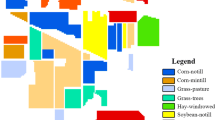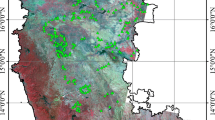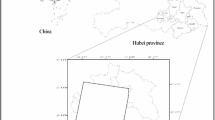Abstract
Feature reduction (FR) methods can effectively reduce the feature set and improve the accuracy for land cover classification (LCC) using high resolution remote sensing data with high dimensional or strongly correlated feature sets. However, FR methods have rarely been applied for LCC in arid regions with complex geographic environments, especially for the integration of feature selection (FS) and feature extraction (FE) methods. This study investigated the comparison and integration of FR methods for LCC in part of Dunhuang Basin, northwestern China, which is a typical inland arid region and groundwater-dependent ecosystems. Five spectral bands and 9 vegetation indices features that derived from RapidEye satellite imagery were used with support vector machines algorithm. Two wrapper FS methods, based on random forest algorithm (varSelRF and Boruta packages in R software), were used. Three FE methods (principal component analysis, PCA; independent component analysis, ICA; and minimum noise fraction transformation, MNF), were employed to extract a reduced number of reconstructed new features. Integration of varSelRF and PCA methods (varSelRF-PCA) was attempted. All 14 features were relevant, indicated by Boruta method; only 6 features, including the red-edge band selected by the varSelRF module, had higher importance. All the five FR methods could improve classification accuracy, but only varSelRF achieved significant improvement. The varSelRF outperformed the FE methods, followed by MNF, PCA, and ICA. The proposed varSelRF-PCA model significantly improved classification accuracy and outperformed all the FS or FE methods.



Similar content being viewed by others
References
Adelabu S, Mutanga O, Adam E (2014) Evaluating the impact of red-edge band from Rapideye image for classifying insect defoliation levels. ISPRS J Photogramm Remote Sens 95:34–41
Barron OV, Emelyanova I, Van Niel TG (2014) Mapping groundwater-dependent ecosystems using remote sensing measures of vegetation and moisture dynamics. Hydrol Process 28:372–385
Belgiu M, Drăguţ L (2016) Random forest in remote sensing: a review of applications and future directions. ISPRS J Photogramm Remote Sens 114:24–31
Bharti KK, Singh PK (2015) Hybrid dimension reduction by integrating feature selection with feature extraction method for text clustering. Expert Syst Appl 42:3105–3114
Breiman L (2001) Random forests. Mach Learn 45:5–32
Cánovas-García F, Alonso-Sarría F (2015) Optimal combination of classification algorithms and feature ranking methods for object-based classification of submeter resolution Z/I-imaging DMC imagery. Remote Sens 7:4651–4677
Chen P, Tremblay N, Wang J, Vigneaulta P (2010) New index for crop canopy fresh biomass estimation. Spectrosc Spectr Anal 30:512–517 (in Chinese)
Chen W, Li X, Wang Y, Chen G, Liu S (2014a) Forested landslide detection using LiDAR data and the random forest algorithm: a case study of the three gorges, China. Remote Sens Environ 152:291–301
Chen W, Sun Z, Wang Y, Ma R (2014b) Major scientific issues on water demand studying for groundwater-dependent vegetation ecosystems in inland arid regions. Earth Sci: J China U Geosci 39:1340–1348 (In Chinese)
Chen G, Li X, Chen W, Cheng X, Zhang Y, Liu S (2014c) Extraction and application analysis of landslide influential factors based on LiDar dem: a case study in the three gorges area, China. Nat Hazards 74:509–526
Chen X, Fang T, Huo H, Li D (2015) Measuring the effectiveness of various features for thematic information extraction from very high resolution remote sensing imagery. IEEE Trans Geosc Remote Sens 53:4837–4851
Chen W, Wang Y, Li X, Zou Y, Liao Y, Yang C (2016) Land use/land cover change and driving effects of water environment system in Dunhuang Basin, northwestern China. Environ Earth Sci 75:1027
Development Core Team R (2013) R: a language and environment for statistical computing. R Foundation for Statistical Computing, Vienna
Diaz-Uriarte R (2010) VarSelRF: variable selection using random forests; R package version 0.7–3. TU Wien, Vienna
Duro DC, Franklin SE, Dubé MG (2012) Multiscale object-based image analysis and feature selection of multi-sensor earth observation imagery using random forests. Int J Remote Sens 33:4502–4526
ENVI (2009) The Environment for Visualizing Images (ENVI) 4.7. User’s Guide: Research System Institute
Fan H (2013) Land-cover mapping in the Nujiang grand canyon: integrating spectral, textural, and topographic data in a random forest classifier. Int J Remote Sens 34:7545–7567
Fassnacht FE, Neumann C, Förster M, Buddenbaum H, Ghosh A, Clasen A, Josh PK, Koch B (2014) Comparison of feature reduction algorithms for classifying tree species with hyperspectral data on three central European test sites. IEEE J Sel Top Appl Earth Observ Remote Sens 7:2547–2561
Ge X, Ni J, Li Z, Hu R, Ming X, Ye Q (2013) Quantifying the synergistic effect of the precipitation and land use on sandy desertification at county level: a case study in Naiman banner, northern China. J Environ Manag 123:34–41
Gitelson A, Merzlyak MN (1994) Spectral reflectance changes associated with autumn senescence of Aesculus hippocastanum L. and Acer platanoides L. leaves. Spectral features and relation to chlorophyll estimation. J Plant Physiol 143:286–292
Gitelson AA, Kaufman YJ, Merzlyak MN (1996) Use of a green channel in remote sensing of global vegetation from EOS-MODIS. Remote Sens Environ 58:289–298
Gou S, Gonzales S, Miller GR (2015) Mapping potential groundwater-dependent ecosystems for sustainable management. Groundwater 53:99–110
Green RO, Eastwood ML, Williams O (1988) A transformation for ordering multispectral data in terms of image quality with implications for noise removal. IEEE Trans Geosci Remote Sens 26:65–74
Han L, Wan X, Fang F, Zhang Z (2013) Desertification assessments of Hexi regions in Gansu province by remote sensing. Arid Land Geogr 36:131–138 (In Chinese)
Han L, Zhang Z, Zhang Q, Wan X (2015) Desertification assessments in the Hexi corridor of northern China’s Gansu Province by remote sensing. Nat Hazards 75:2715–2731
Hao C, Wu S (2006) The effects of land-use types and conversions on desertification in mu us Sandy land of China. J Geogr Sci 16:57–68
Helwig NE (2015) Ica: independent component analysis; R package version 1.0–1. TU Wien, Vienna
Huang X, Zhang L (2013) An SVM ensemble approach combining spectral, structural, and semantic features for the classification of high-resolution remotely sensed imagery. IEEE Trans Geosci Remote Sens 51:257–272
Hyvarinen A (1999) Fast and robust fixed-point algorithms for independent component analysis. IEEE Transactions on Neural Netw 10:626–634
Hyvarinen A, Karhunen J, Erkki O (2001) Independent component analysis. Wiley, New York
Jones T, Coops NC, Sharma T (2010) Assessing the utility of airborne hyperspectral and LiDAR data for species distribution mapping in the coastal Pacific northwest, Canada. Remote Sens Environ 114:2841–2852
Jordan CF (1969) Derivation of leaf-area index from quality of light on the forest floor. Ecology 50:663–666
Key T, Warner TA, McGraw JB, Fajvan MA (2001) A comparison of multispectral and multitemporal information in high spatial resolution imagery for classification of individual tree species in a temperate hardwood forest. Remote Sens Environ 75:100–112
Kim HO, Yeom JM (2014) Effect of red-edge and texture features for object-based paddy rice crop classification using RapidEye multi-spectral satellite image data. Int J Remote Sens 35:7046–7068
Kursa MB, Rudnicki WR (2010) Feature selection with the Boruta package. J Stat Softw 36:1–13
Ladha L, Deepa T (2011) Feature selection methods and algorithms. Int J Comp Sci Eng 3:1787–1797
Laliberte AS, Browning DM, Rango A (2012) A comparison of three feature selection methods for object-based classification of sub-decimeter resolution UltraCam-L imagery. Int J Appl Earth Obs Geoinf 15:70–78
Li X, Cheng X, Chen W, Chen G, Liu S (2015) Identification of forested landslides using LiDar data, object-based image analysis, and machine learning algorithms. Remote Sens 7:9705–9726
Li X, Chen W, Cheng X, Wang L (2016) A comparison of machine learning algorithms for mapping of complex surface-mined and agricultural landscapes using ZiYuan-3 stereo satellite imagery. Remote Sens 8:514
Liu P, Choo KKR, Wang L Huang F (2016) SVM or deep learning? A comparative study on remote sensing image classification. Soft Comput. doi:10.1007/s00500-016-2247-2
Lv J, Wang X, Zhou Y, Qian K, Wan L, Eamus D, Tao Z (2013) Groundwater-dependent distribution of vegetation in Hailiutu River catchment, a semi-arid region in China. Ecohydrology 6:142–149
Ma Y, Wu H, Wang L, Huang B, Ranjan R, Zomaya A, Jie W (2015) Remote sensing big data computing: challenges and opportunities. Futur Gener Comp Syst 51:47–60
Manandhar R, Odeh IOA, Ancev T (2009) Improving the accuracy of land use and land cover classification of Landsat data using post-classification enhancement. Remote Sens 1:330–344
Melgani F, Bruzzone L (2004) Classification of hyperspectral remote sensing images with support vector machines. IEEE Trans Geosci Remote Sens 42:1778–1790
Meyer D, Dimitriadou E, Hornik K, Weingessel A, Leisch F (2014) e1071: Misc functions of the Department of Statistics (e1071); R package version 1.6–4. TU Wien, Vienna
Namdar M, Adamowski J, Saadat H, Sharifi F, Khiri A (2014) Land-use and land-cover classification in semi-arid regions using independent component analysis (ICA) and expert classification. Int J Remote Sens 35:8057–8073
Pal M, Foody GM (2010) Feature selection for classification of hyperspectral data by SVM. IEEE Trans Geosci Remote Sens 48:2297–2307
Pearson K (1901) On lines and planes of closest fit to systems of points in space. Philos Mag 2:559–572
Peerbhay KY, Mutanga O, Ismail R (2013) Commercial tree species discrimination using airborne AISA eagle hyperspectral imagery and partial least squares discriminant analysis (PLS-DA) in Kwazulu–Natal, South Africa. ISPRS J Photogramm Remote Sens 79:19–28
Peerbhay KY, Mutanga O, Ismail R (2014) Does simultaneous variable selection and dimension reduction improve the classification of Pinus forest species? J Appl Remote Sens 8:085194
Petropoulos GP, Kalaitzidis C, Vadrevu KP (2012) Support vector machines and object-based classification for obtaining land-use/cover cartography from Hyperion hyperspectral imagery. Comput Geosci 41:99–107
Pontius RG, Millones M (2011) Death to kappa: birth of quantity disagreement and allocation disagreement for accuracy assessment. Int J Remote Sens 32:4407–4429
Rouse JW, Haas RH, Schell JA (1974) Monitoring the vernal advancement and Retrogradation (Greenwave effect) of natural vegetation. Texas A&M University, College Station
Saadat H, Adamowski J, Bonnell R, Sharifi F, Namdar M, Ale-Ebrahim S (2011) Land use and land cover classification over a large area in Iran based on single date analysis of satellite imagery. ISPRS J Photogramm Remote Sens 66:608–619
Sawilowsky S (2007) Mann–Whitney U test (Wilcoxon rank-sum test). In: Salkind N (ed) Encyclopedia of measurement and statistics. SAGE, Newbury Park, pp 566–568
Schuster C, Förster M, Kleinschmit B (2012) Testing the red edge channel for improving land-use classifications based on high-resolution multi-spectral satellite data. Int J Remote Sens 33:5583–5599
Song W, Liu P, Wang L (2016) Sparse representation-based correlation analysis of non-stationary spatiotemporal big data. Int J Digital Earth 9(9):892–913
Stumpf A, Kerle N (2011) Object-oriented mapping of landslides using random forests. Remote Sens Environ 115:2564–2577
Sun A, Chen T, Niu R, Trinder JC (2016) Land use/cover change and the urbanization process in the Wuhan area from 1991 to 2013 based on MESMA. Environ Earth Sci 75(17):1214
Vapnik V (1995) The nature of statistical learning theory. Springer-Verlag, Inc., New York
Wang X, Chen F, Dong Z (2005) The relative role of climatic and human factors in desertification in semiarid China. Globa Environ Change 16:48–57
Wang L, Song W, Liu P (2016a) Link the remote sensing big data to the image features via wavelet transformation. Cluster Comput 19:793–810
Wang L, Ma Y, Yan J, Chang V, Zomaya AY (2016b) pipsCloud: high performance cloud computing for remote sensing big data management and processing. Futur Gener Comp Syst. doi:10.1016/j.future.2016.06.009
Wang L, Zhang J, Liu P, Choo KKR, Huang F (2017) Spectral–spatial multi-feature-based deep learning for hyperspectral remote sensing image classification. Soft Comput 21:213–221
Xu D, Li C, Zhuang D, Pan J (2011) Assessment of the relative role of climate change and human activities in desertification: a review. J Geogr Sci 21:926–936
Yan WY, Shaker A, El-Ashmawy N (2015) Urban land cover classification using airborne LiDAR data: a review. Remote Sens Environ 158:295–310
Zha F, Ma M, Chen S, Liu Y, Li Y, Huang S (2015) Remote sensing Lithologic classification of multispectral data based on the vegetation inhibition method in the vegetation coverage area. Earth Sci 40(8):1403–1408 (In Chinese)
Acknowledgements
This research was jointly supported by the China Geological Survey project (No. 12120115063201), the Fundamental Research Funds for Central Universities, China University of Geosciences (Wuhan) (No. CUGL150417), and the China Scholarship Council (No. 201406415051).
Author information
Authors and Affiliations
Corresponding author
Ethics declarations
Conflict of interest
The authors declare that they have no conflict of interest.
Rights and permissions
About this article
Cite this article
Li, X., Chen, W., Cheng, X. et al. Comparison and integration of feature reduction methods for land cover classification with RapidEye imagery. Multimed Tools Appl 76, 23041–23057 (2017). https://doi.org/10.1007/s11042-016-4311-4
Received:
Revised:
Accepted:
Published:
Issue Date:
DOI: https://doi.org/10.1007/s11042-016-4311-4




